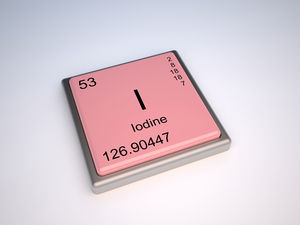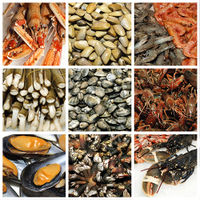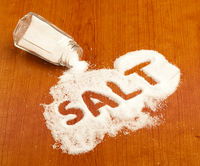Iodine
| See Also | Minerals |
|---|
| Article | Nutrient Profile: Iodine, NMJ, [2], 2012 April |
|---|
Iodine is a trace mineral which is crucial for the synthesis of thyroid hormone. It also appears to modulate the effect of estrogen on breast tissue. Two main forms of iodine are available which appear to have different effects on the body. Elemental iodine primarily exerts its effects outside the thyroid, namely on breast tissue. Iodine complexed with sodium or potassium for instance, is known as an iodide. Iodide complexes exert a stronger effect on the thyroid gland. [1]
Contents
Food Sources
The following foods have the highest concentration of iodine. For a more expansive list on food sources of specific nutrients visit Health Canada's Dietary Reference Intakes for Elements or USDA's National Nutrient Database
- Natures Richest Sources: seafoods, including seaweeds like kelp
- The majority of iodine in the U.S. comes from salt which has been iodinated. Sea salt has very little iodine in comparison.
Other food sources include:[2]
- protein sources: Cod, sea bass, haddock, and perch
- dairy: most dairy products
Uses
The following are the primary uses of iodine. [1]
- Prevention of iodine deficiency: The primary use of iodine is to treat deficiency.
- Fibrocystic Breast Disease: Iodine caseinate has been used to treat fibrocystic breast disease. The hypothesis is that deficiency in iodine causes the epithelium in the breast tissue to be more sensitive to estrogen stimulation. This causes distention of the breast ducts, forming small cysts and later fibrosis. Elemental iodine appears to be the preferential form of iodine in this case. A possible side effect of elemental iodine use may be short-term increased breast tenderness on examination.
Deficiency Symptoms
A wide spectrum of conditions may result from a deficiency in iodine, which may include:
- goiter
- cretinism
- intellectual disability
- growth retardation
| Article | The Delicate Balance of Iodine in Thyroid Health, NDNR; 2012 August |
|---|
- hypothyroidism
- hyperthyroidism
- increased early- and late- pregnancy miscarriage
- increased infant mortality
There are several foods that block iodine utilization and can lead to deficiency. These are known as goitrogens and include:
- turnips
- cabbage
- mustard
- cassava root
- soybean
- peanuts
- pine nuts
- millet
Cooking usually inactivates goitrogens.
Excess Symptoms
Adverse reactions have occurred with pharmacological doses including:[3]
- hypersensitivity reactions
- flare-up of adolescent acne
- rashes
- arrhythmia
- central nervous system effects (confusion, numbness, tingling, weakness in the hands and feet)
- hypothyroidism or hyperthyroidism (Jod-Basedow phenomenon)
- parotitis (iodide mumps)
- thyroid adenoma
- small bowel lesions.
Hypersensitivity reactions include angioedema, symptoms resembling serum sickness, cutaneous and mucosal hemorrhages, urticaria, thrombotic thrombocytopenia purpura (TTP) and fatal periarteritis. Enteric coated potassium iodine has caused nonspecific small bowl lesions manifested by stenosis with or without ulcerations
Assessment Procedure
Best specimens to collect: [4]
- Serum T4 - a low level indicates a deficiency
Prescribing Considerations
- Organic sources of iodine such as kelp and iodine caseinate etc. are preferred to inorganic iodides such as potassium iodide and sodium iodide [1]
- Potassium iodide is available as a nutritional supplement usually in combination products.
- Iodine content in iodized salt ranges from 20-40mg/kg or 20-40mcg/g [3].
- The recommended dosages varies based on age and health status. To determine what your specific requirements are talk to your naturopathic doctor or other trained medical professional.
- Infants: 40 mcg (under 6 months); 50 mcg (6-12 months)
- Child: 70 mcg (1-3 years); 90 mcg (4-6 years); 120 mcg (7-10 years)
- Adolescent - Adult (11+ years): 150 mcg
- Pregnancy: 175 mcg
- Lactation: 200 mcg
Safety
- General Side Effects:
- Short term oral iodide administration at doses between 1500 mcg - 250 mg/day can reduce thyroid hormone secretion. In individuals with borderline hypothyroidism, doses as low as 750 mcg may inhibit thyroid hormone secretion. Increased dietary intake has been associate with acne-like skin eruptions. [1]
- Chronic intake at pharmacological doses can lead to iodism characterized by frontal headache, pulmonary edema, coryza, eye irritation, skin eruptions, gastric disturbances, and inflammation of the tonsils, larynx, pharynx, and submaxillary and parotid glands [3]
- The most common adverse effect of salt iodization is iodine-induced hyperthyroidism (IIH). This typically affects older people with nodular goiter. Theoretically it can also induce hypothyroidism but this has not been a reported side effect. Allergic response to iodized salt is rare [3]
- Children: Children with cystic fibrosis appear to have an exaggerated susceptibility to the goitrogenic effect of high doses of iodide.
- Seniors: Older people with nodular goiters are a risk of developing hyperthyroidism from use of potassium iodide and iodized salt.
- Pregnancy and Breastfeeding: Avoid intake greater than the RDAs. Doses above 175 mcg in a pregnant women may cause fetal damage. Doses above 200 mcg in a nursing mother may cause rash and thyroid suppression in the infant.
- Contraindications: individuals with hypersensitivity to iodine or iodide products
- Precautions: Potassium iodide and iodized salt may exacerbate symptoms in some with autoimmune thyroiditis.
Drug Interactions
- Drug Interactions include: [3]
- Antithyroid Drugs - Concomitant use of antithyroid drugs and iodide may potentiate the hypothyroid effect of iodides.
- Lithium - Concomitant use of pharmacological doses of potassium iodide and lithium may result in hypothyroidism.
- Warfarin - Concomitant use of pharmacological doses of potassium iodide (for hyperthyroidism) and warfarin may decrease the anticoagulant effectiveness of warfarin.
Nutrient Interactions
- Nutrient Interactions include: [3]
- Selenium - Intake of selenium and iodide may have a synergistic effect in the treatment of Kashin-Beck disease, an osteoarthropathy.
- Goitrogenic foods - Goitrogens contain a substance that is metabolized to a compound that may compete with iodide and negatively effect iodide status potentially leading to hypothyroidism. These foods include cassava and cruciferous foods such as cabbage, brussels sprouts, broccoli, cauliflower, and rutabaga. Certain flavonoids also have goitrogenic activity.
References
- ↑ 1.0 1.1 1.2 1.3 Murray Michael T (2005) Encyclopedia of Nutritional Supplements, The Essential Guide for Improving Your Health Naturally, Prima Publishing
- ↑ Medlineplus [1]
- ↑ 3.0 3.1 3.2 3.3 3.4 3.5 Hendler Sheldon S., Rorvik David (Editors) (2008) PDR for Nutritional Supplements, Medical Economics Company Inc.
- ↑ Bralley J Alexander and Lord Richard S (2005) Laboratory Evaluations in Molecular Medicine, Nutrients, Toxicants, and Cell Regulators Institute for Advances in Molecular Medince, GA


